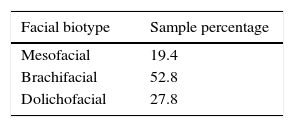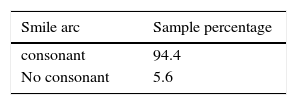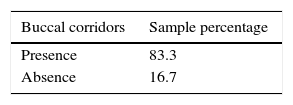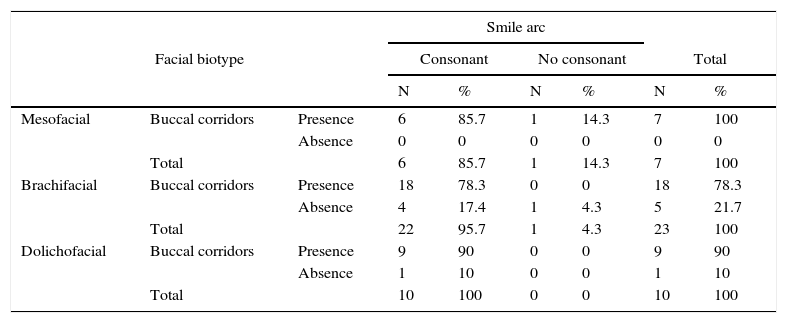The correlation between the aesthetic characteristics of the smile and the facial biotype, could be useful in the design of the treatment plan.
ObjectivesTo assess the relationship between Facial Biotype and the smile aesthetics evaluating the smile arc and the presence or absence of buccal corridors in subjects with normocclusion.
MethodsFrom a sample of 100 subjects with normocclusion, 40 of them were randomly selected, 22 women and 18 men between 18 to 25 years, without temporomandibular joint or periodontal problems and without prior orthodontic treatment. Fontal photographs of social or posed smiles were used to determine the smile arc (consonant or not consonant) and the presence or absence of buccal corridors.
Results82.5% of the subjects showed a brachifacial biotype, with presence of buccal corridors and a consonant smile arc. No statistically significant relation was found between the facial biotype and the smile arc or with the presence or absence of buccal corridors.
ConclusionsAesthetic characteristics of the smile such as the smile arc and buccal corridors are present in subjects with normocclusion and are not affected by the facial biotype.
La correlación entre las características estéticas de la sonrisa y el biotipo facial, podría ser útil en el diseño del plan de tratamiento.
ObjetivosEvaluar la relación entre el biotipo facial y la estética de la sonrisa, evaluando el arco de sonrisa y la presencia o ausencia de corredores bucales en sujetos con normoclusión.
MétodoDe una muestra de 100 sujetos con normoclusión se seleccionaron aleatoriamente 40 de ellos, 22 mujeres y 18 hombres, entre 18 a 25 años, sin problemas articulares ni periodontales y sin previo tratamiento de ortodoncia. Se utilizaron fotografías frontales en sonrisa de pose para determinar el arco de sonrisa (consonante o no consonante) y la presencia o ausencia de corredores bucales.
ResultadosEl 82.5% de los sujetos mostraron un biotipo braquifacial, con presencia de corredores bucales y arco de sonrisa consonante. No se encontró una relación estadísticamente significativa entre el biotipo facial y el arco de sonrisa ni la presencia o ausencia de corredores bucales.
ConclusionesLas características estéticas de la sonrisa tales como el arco de sonrisa y la presencia de corredores bucales están presentes en los sujetos con normoclusión y no se ven afectadas por el biotipo facial.
The smile is the result of the sum of several attributes. The value of an attractive smile is undeniable. It is an important form of facial expression. An esthetic smile is associated with intelligence, sympathy, extroversion, and exerted degree of attraction. Studies show that in subjects with aesthetic smiles greater social and intellectual skills are attributed to them. A friendly smile helps win elections, sell products and gives credibility. However, there are few objective criteria to determine the ideal attributes in the smile.1–6
The language is filled with words that describe different types of smile: warm, enigmatic, sardonyx, cordial, hypocritical, ironic, inscrutable, terrifying, friendly, mischievous, seductive, etc. Nonetheless, all these descriptions continue to be subjective.7
There are few objective criteria to assess smile attributes, establish therapeutic objectives relating to the relationship between lips and teeth and measure the results of orthodontic therapy. Without morphogenic data on smile characteristics, orthodontists have no choice but to be subjective in its evaluation.1,2 The assessment of beauty in the human body is clearly subjective. Similarly, the characteristics that make a beautiful face or smile seem to be intangible. However, scientific research has revealed systematic and repeatable objective characteristics that can be methodologically applied to analyze and alter dental aesthetics and smile.
Smile design is the objective assessment of the presence or absence of desirable esthetic features in a smile. Each aesthetic principle can be considered and analyzed individually, but it is its collective influence which creates the ultimate smile impact.8,9
According to different authors10,11 a spontaneous smile is involuntary and induced by joy or delight. It is dynamic, it triggers but is not maintained. All facial expression muscles are involved in the process, which leads to a pronounced deepening of the nasolabial folds and a characteristic gaze. It is natural. It expresses a genuine human emotion.
A social or posed smile is voluntary and does not require to be accompanied by emotions. It is static, it can be maintained. It may appear tense and unnatural. However, it is assessed repeatable, so it is considered optimal for analyzing the different elements that make up the smile. Talking about aesthetics will always be subjective. However, it is important that orthodontists are familiar with the features that make a smile aesthetic and to have repeatable and measurable parameters so as to be able to provide the best results for their patients.12,13
There is a gap in the specialized texts in orthodontics as far smile aesthetics is concerned. Desirable occlusal characteristics are well defined, but this does not guarantee that the visual effect is aesthetic, or that it is in harmony with the patient's face.
Patients have diverse facial biotypes and the smile must be in harmony with the face to create an aesthetic effect.
The smile arc is the relationship between a hypothetical curve that runs through the incisal edges of the anterior upper teeth, and the curve that the lower lip forms in a posed smile. In a «consonant» or «positive» smile arc (Figure 1) both curves match. In a «non-consonant» smile arc (Figure 2) the curve formed by the incisal edges of the anterior upper teeth is flat, or inverse with respect to the curvature of the lower lip.14
At smile bilateral spaces appear between the buccal surface of the most posterior visible maxillary tooth and the corner of the mouth. They are called buccal corridors, negative spaces or dark spaces14(Figure 3). The prosthodontic literature describes that the lack of buccal corridors produces an unreal appearance of the smile, giving it an appearance that suggests that the subject has artificial teeth15(Figure 4).
The main reason for which patients are willing to undergo orthodontic treatment is the search for dental aesthetics. Several of them refer not feeling confident when smiling or having to cover their mouths with their hand when doing so, due to the condition in which their mouth is and that they perceive as being non-aesthetic. The esthetic assessment of the results of an orthodontic treatment is important because that was the original motivation by which the patient sought specialized professional attention. By knowing the objective and modifiable factors that determine smile aesthetics, the orthodontist will be in a position to offer his patients the aesthetic result they seek since the moment they ask for orthodontic care, and he or she will also be able to adapt it to each patient according to their facial biotype.
MATERIAL AND METHODSThe study population consisted of 40 subjects between 18 and 25 years of age with normocclusion, without prior orthodontic treatment or restorations in the occlusal faces of their teeth. The frontal smile photography for each patient (Figure 5), was obtained by positioning the subject's head with the Frankfurt plane parallel to the ground with the help of a positioning laser, and placing a camera (Sony Cyber-shot DSC-P100) on a tripod a meter away. In each photograph the type of arc smile (consonant or consonant not) that the patient presented was assessed as well as the presence or absence of buccal corridors.
Lateral head films were taken with the equipment of the Radiology Department at the Division of Postgraduate Studies and Research at the Faculty of Dentistry of the UNAM (Orthopos XG, Sirona), and positioning the head of each patient with the Frankfurt plane parallel to the ground. Digital radiographs were obtained and in each one of them Ricketts VERT was measured using the software Nemoceph NX 2008, thereby determining the facial biotype of each subject.
The obtained data were analyzed with the SPSS-19software, by applying the χ2 statistical test. Four subjects were eliminated from the study sample because of lack of sharpness in their X-rays or photographs.
RESULTS82.5% of the subjects showed a brachifacial biotype with presence of buccal corridors and a consonant smile arc. The percentual distribution of the variables considered in this study appears in tables I to III. No statistically significant relation was found between the facial biotype and the type of smile arc (χ2 = 1,608 p = .448). Nor was it found a statistically significant relationship between facial biotype and the presence or absence of buccal corridors (χ2 = 2,994 p = .224). Data distribution according to the subject's facial biotype is found in tables I to IV.
Percentage distribution and number of cases in the sample, according to facial biotype.
| Smile arc | ||||||||
|---|---|---|---|---|---|---|---|---|
| Facial biotype | Consonant | No consonant | Total | |||||
| N | % | N | % | N | % | |||
| Mesofacial | Buccal corridors | Presence | 6 | 85.7 | 1 | 14.3 | 7 | 100 |
| Absence | 0 | 0 | 0 | 0 | 0 | 0 | ||
| Total | 6 | 85.7 | 1 | 14.3 | 7 | 100 | ||
| Brachifacial | Buccal corridors | Presence | 18 | 78.3 | 0 | 0 | 18 | 78.3 |
| Absence | 4 | 17.4 | 1 | 4.3 | 5 | 21.7 | ||
| Total | 22 | 95.7 | 1 | 4.3 | 23 | 100 | ||
| Dolichofacial | Buccal corridors | Presence | 9 | 90 | 0 | 0 | 9 | 90 |
| Absence | 1 | 10 | 0 | 0 | 1 | 10 | ||
| Total | 10 | 100 | 0 | 0 | 10 | 100 | ||
The objective of this research was to determine if the type of smile arc and the presence of buccal corridors are associated with a facial biotype. Normally, smile analysis has been considered as a separate entity from cephalometric tracings and clinical examination, hence it is common not to take it into consideration during treatment planning.8 In our results, 82.5% of the subjects had a brachifacial biotype with presence of buccal corridors and a positive smile arc. While no other studies that try to associate facial biotype with these smile aesthetic characteristics have been reported, the results of Christie16 suggest that brachifacial subjects are more likely to develop a normal occlusion, which coincides with our results.
A consonant smile arc has been considered by several authors6,10,11,16 as an aesthetic factor of the smile, but the results of Peck,13 Hulsey17 and Tjan18 demonstrate that a high percentage of patients who have undergone orthodontic treatment, at the end of it, exhibit a flat or neutral arc. Goldstein19 and Frush20 established a correlation between a non-consonant smile arc with an older appearance. By having selected subjects without prior orthodontic treatment we were able to assess the normal development of the smile arc in subjects with normocclusion.
Ritter15 and Goldstein19 agree with the aesthetic importance of buccal corridors at smile which is in contrast with the results of Hulsey, who reports that people outside the dental environment do not have a preference of a smile that presents buccal corridors over one that doesn’t. However, our results suggest that subjects with normal occlusions and positive smile arcs tend to also have buccal corridors.
CONCLUSIONS- •
Aesthetic characteristics of the smile such as a consonant smile arc and the presence of buccal corridors are present in subjects with normocclusion and are not affected by facial biotype.
- •
Among orthodontic treatment objectives it should be considered to provide or maintain a consonant smile arc and the buccal corridors.
This article can be read in its full version in the following page: http://www.medigraphic.com/ortodoncia

















